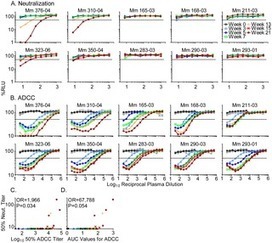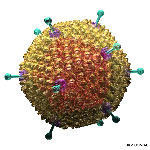I started working on human papillomaviruses (HPVs) some 22 years ago, back at the dawn of PCR: I helped my then-new major collaborator (and wife of 2 years), Anna-Lise Williamson, design some degenerate primers for amplifying as wide a range as possible of high-risk HPVs from cervical biopsy samples. These worked pretty well, and are still highly useful for the purpose, despite the many novel types found since then.

 We went on to do another two papers together on looking at variation and typing of HPVs via PCR and and sequencing, then took a deviation into making candidate vaccines for HPV and HIV. Anna-Lise carried on with surveilling for HPVs, however, and has ended up with a WHO Regional Laboratory for HPV work. She also started working on HPV infections in HIV-infected women: work on a study cohort showed that while HIV-free women usually had only 1 HPV type, the 109 HIV-infected often were infected with multiple HPV types. In association with Anna Salimo in my lab, we started a deep sequencing pilot study on the sample with the most HPVs. This turned this into a regional study, with help on assembling and interpreting sequence data from Prof Johan Burger’s lab at the University of Stellenbosch, and it was revelatory: while a commercial kit could detect 12 HPV types in one sample, next-gen sequencing found 16.
We went on to do another two papers together on looking at variation and typing of HPVs via PCR and and sequencing, then took a deviation into making candidate vaccines for HPV and HIV. Anna-Lise carried on with surveilling for HPVs, however, and has ended up with a WHO Regional Laboratory for HPV work. She also started working on HPV infections in HIV-infected women: work on a study cohort showed that while HIV-free women usually had only 1 HPV type, the 109 HIV-infected often were infected with multiple HPV types. In association with Anna Salimo in my lab, we started a deep sequencing pilot study on the sample with the most HPVs. This turned this into a regional study, with help on assembling and interpreting sequence data from Prof Johan Burger’s lab at the University of Stellenbosch, and it was revelatory: while a commercial kit could detect 12 HPV types in one sample, next-gen sequencing found 16.
We went on to do PCR on all 109 samples in the cohort with specific primers for the types not found by the kit, and showed prevalences up to 15% in the HIV-infected group. This is an important result, because otherwise-innocuous HPV types that do not show up in normal women, may well be associated with disease in the HIV-infected – and will probably not be protected against by the current HPV vaccines.
We continue to do work on these samples, and it will be very interesting to see what the new methodologies show up. Especially as sequencing becomes cheaper, and we can do more samples…! Meantime, we have published the pilot study:
Published: 16 August 2012
Abstract (provisional)
Background
Human papillomavirus (HPV) is the aetiological agent for cervical cancer and genital warts. Concurrent HPV and HIV infection in the South African population is high. HIV positive (+) women are often infected with multiple, rare and undetermined HPV types. Data on HPV incidence and genotype distribution are based on commercial HPV detection kits, but these kits may not detect all HPV types in HIV + women. The objectives of this study were to (i) identify the HPV types not detected by commercial genotyping kits present in a cervical specimen from an HIV positive South African woman using next generation sequencing, and (ii) determine if these types were prevalent in a cohort of HIV-infected South African women.
Methods
Total DNA was isolated from 109 cervical specimens from South African HIV + women. A specimen within this cohort representing a complex multiple HPV infection, with 12 HPV genotypes detected by the Roche Linear Array HPV genotyping (LA) kit, was selected for next generation sequencing analysis. All HPV types present in this cervical specimen were identified by Illumina sequencing of the extracted DNA following rolling circle amplification. The prevalence of the HPV types identified by sequencing, but not included in the Roche LA, was then determined in the 109 HIV positive South African women by type-specific PCR.
Results
Illumina sequencing identified a total of 16 HPV genotypes in the selected specimen, with four genotypes (HPV-30, 74, 86 and 90) not included in the commercial kit. The prevalence’s of HPV-30, 74, 86 and 90 in 109 HIV positive South African women were found to be 14.6 %, 12.8 %, 4.6 % and 8.3 % respectively.
Conclusions
Our results indicate that there are HPV types, with substantial prevalence, in HIV positive women not being detected in molecular epidemiology studies using commercial kits. The significance of these types in relation to cervical disease remains to be investigated.
I thank Russell Kightley Media for use of the HPV and cervical cancer graphic.







